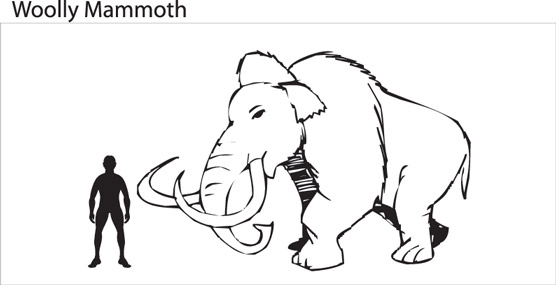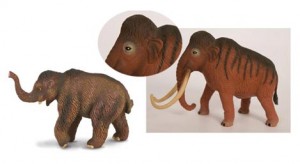Mammoths around in Great Britain much Longer than Previously Thought
Radiocarbon dating information changes the date of the extinction of Woolly Mammoths from the British Isles.
A trip to the beautiful county of Shropshire 14,000 years ago may well have resembled a visit to a safari park as amongst the exotic wildlife around at the time, herds of Woolly Mammoths could still be seen. This is the conclusion of a group of scientists that have recalculated the age of several Mammoth fossils found in the Shropshire. It seems that herds of these iconic Ice Age mammals were wandering around the English countryside, thousands of years after they were thought to have gone extinct.
In research published in the scientific publication “Geological Journal”, researchers from the Natural History Museum in London have re-examined data on five Woolly Mammoth fossils found at Condover, Shropshire in 1986. Improvements in the technology of radiocarbon dating has enabled the scientists to reassess the age of these fossils and their work indicates that these animals died 14,000 years ago, 7,000 years later than previously thought.
Condover, is a small village in the centre of Shropshire, the area is well-known to geologists as there are a number of small fault lines in the region and earthquakes in the vicinity are not unknown. The last substantial quake occurred in 1990. There are a number of sandstone and gravel quarries around the village and it was in one of these gravel pits that the remains of one adult and four juvenile mammoths were discovered in 1986. The skeletons were well preserved and articulated and the site remains one of the best locations known for fossil Mammoths in the UK. There is a model of the Condover Woolly Mammoth on display at the Shropshire Hills Discovery Centre in the nearby town of Craven Arms. Members of Everything Dinosaur have been to Shropshire on many occasions, normally to visit sites such as Ludlow and the Mortimer forest to explore the excellent Silurian aged rock formations and hunt for trilobite fossils.
Radiocarbon Dating Information
However, developments in dating techniques has enabled a team of scientists from the Natural History Museum to reassess the age of the Mammoth remains. The new dates point to climate change as the reason for this elephant’s decline rather than hunting by early humans and Neanderthals.
Commenting on the new data, Professor Adrian Lister (Natural History Museum) stated:
“Mammoths are conventionally believed to have become extinct in north-western Europe about 21,000 years ago during the main ice advance, known as the Last Glacial Maximum”.
However, more sophisticated radiocarbon dating techniques used on bones, plus a new study of the micro fossils, plant and insect fossils found at the site indicate that these large herbivores persisted longer in the United Kingdom than previously thought.
Professor Lister went on to add:
“Our new radiocarbon dating of the Condover mammoths changes that, by showing that Mammoths returned to Britain and survived until around 14,000 years ago”.
The Condover Mammoth Fossils
The Condover Mammoth fossils are the last known record of Mammoths living in the north-west of Europe, their demise seems linked with climate change rather than the pressure of hunting from human settlers. The advance of the ice sheets from the north, led to a change in the habitat, the open grassy plains, (known as Mammoth steppe, due to these large creature’s influence on the ecosystem), gave way to much more conifer forest and scrub. This habitat was not suitable for a large herbivore that grazed on grasses and sedges.
Professor Lister added:
“The new dates of the Mammoths’ last appearance correlate very closely in time to climate changes when the open grassy habitat of the Ice Age was taken over by advancing forests, which provides a likely explanation for their disappearance.
There were humans around during the time of the Condover mammoths, but no evidence of significant mammoth hunting”.
Although Woolly Mammoths are seen as “classical” animals of the Ice Age and they were well adapted to cold climates, they were not limited to cold environments. Types of Mammoths lived throughout the northern hemisphere during the Pleistocene. Contrary to popular belief, Mammoths did not live in habitats dominated by ice and snow but rather on the cold grasslands (steppe) beyond the reach of the ice sheets. Mammoths were well adapted to cold conditions, with small ears (to reduce heat loss), thick set bodies, and two types of body hair to help keep them warm. The outer layer of hair, was thick with long guard hairs, over a metre in length in some cases. This hair was coarse and up to six times thicker than human hair. The under-layer of hair was dense, softer and shorter with individual hairs much thinner than the outer hair covering. This helped trap air which added to the insulation properties of this inner layer of body hair.
Many types of Mammoth had thick skin and a layer of body fat up to 10 cm thick, again providing excellent protection from the cold.
An Illustration of a Woolly Mammoth

Picture credit: Everything Dinosaur
Evidence from frozen Mammoth corpses from Siberia indicate that the hair colouring of Mammoths varied from reddish orange to a dark brown. The Natural History Museum Woolly Mammoth model is depicted as a reddish brown coloured animal whereas other Mammoth models such as the new baby Mammoth model from Procon/CollectA is depicted with the more “traditional” dark brown colouration.
Woolly Mammoth Model Comparisons
Picture credit: Everything Dinosaur
The picture shows the adult Woolly Mammoth model as created by the Natural History Museum in London, the colouration is distinctly reddish with darker hair on the crown of the head and along the back and part way down the flank (inset). The model of the baby Mammoth from the Procon/CollectA prehistoric animal model series, is depicted with a dark brown colouration all over. Note also the different interpretations of nail colour between the two replicas.
To view the range of Woolly Mammoths and other prehistoric mammals available from Everything Dinosaur: Prehistoric Mammal Models and Dinosaurs.







Leave A Comment